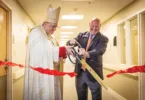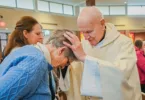Denver’s Archbishop Chaput returns to his Potawatomi family roots
by Joe Bollig
joe.bollig@theleaven.org
POTAWATOMI RESERVATION — Many people don’t know it, but the Cathedral of the Immaculate Conception in Denver and Our Lady of the Snows Shrine here have something in common.
They share Archbishop Charles J. Chaput, OFM Cap.
It’s not that the Archdiocese of Denver has annexed the Potawatomi Reservation. Rather, Catholics at both places can claim a special place in the archbishop’s heart.
Archbishop Chaput, a rising star in the American hierarchy, has been chief shepherd of the Archdiocese of Denver since 1997. He has been associated with the Potawatomi Tribe, however, his whole life.
Long before people called him “Archbishop,” or “Bishop,” or even “Father,” his own family called him “Pyet-ta-sen,” or “Wind is Stirring the Leaves.” He has a Potawatomi name because he is an enrolled member of the tribe. He is one of only three Native American bishops in the United States.
Archbishop Chaput’s responsibilities usually keep him in Colorado, but he made a special effort to travel to Kansas and preside at a Mass on April 13 for Potawatomi Catholics at the shrine.
“[Visiting] brings back a lot of memories of my family, so I’m happy to come back for those memories,” said Archbishop Chaput during an interview after the Mass.
“But it also reminds me that the Catholic tradition among the Potawatomi people is both old and strong,” he added, “and I hope that my coming to the reservation is a reminder to the people of their Catholic — as well as their native — heritage, and that it will strengthen their relationship with Christ.”
Archbishop Chaput was born and raised in Concordia, which is about 80 miles west of the reservation. He still has cousins living on the reservation and he used to visit it often while a young priest living in Kansas City, Mo.
The visits had become fewer, however, as he assumed more responsibilities in the Capuchin Franciscan order, then was named bishop of the Diocese of Rapid City, S.D., in 1988, and finally prelate of the Archdiocese of Denver.
Father Bob Hasenkamp, former shrine chaplain and now pastor of St. Theresa Parish in Perry and St. Aloysius in Meriden, invited the archbishop to make this visit two years ago. The press of archdiocesan demands, however, made it difficult for Archbishop Chaput to find an open date — something that Archbishop Joseph F. Naumann, who concelebrated the Mass, knows well.
“Time is precious for us all,” said Archbishop Naumann to the Potawatomi community, “and weekends are particularly precious for bishops. It’s reflective of [Archbishop Chaput’s] great love for you and for this community that he would give this time to be with us, and we are honored by his presence.”
Concelebrating with the two archbishops were Father Richard Halvorson, the shrine chaplain and also pastor of St. Dominic Parish in Holton and St. Francis Xavier Parish in Mayetta; Father Hasenkamp; and fellow Capuchin Father Duane Reinert, director of counseling services at Conception Seminary, who celebrates Masses at the shrine three Sundays a month.
Archbishop Chaput wasn’t the only Potawatomi cleric at the shrine that day. Deacon Scott Aikin, who serves at St. Joseph Parish in Vancouver, Wash., assisted at the altar. As a child, Deacon Aikin made several visits to the reservation, where his grandfather was a spiritual leader in the Native American Drum Religion.
During a potluck dinner following the Mass, Cornelia Donahue prayed the “Hail Mary” in Potawatomi. Tribal Council Chairman Steve Ortiz (Monwa) and parish representatives presented blankets, traditional Potawatomi gifts, to Archbishop Chaput and Deacon Aikin.
Catholic Potawatomis have a long presence in this area
The oldest Catholic community in the Archdiocese of Kansas City in Kansas is not any immigrant group from Europe, but rather the Potawatomis.
There have been Catholic Potawatomis since the 1670s, when French Jesuits welcomed the first Potawatomi converts at missions established in the Great Lakes region.
When the Potawatomis were deported from Indiana in 1838, they did not leave behind their Catholic faith. They were accompanied by Father Benjamin Marie Petit. He later became ill at the Sugar Creek mission in Kansas and was taken to St. Louis, where he died.
When they arrived in Kansas, the Potawatomis first lived near Osawatomie, and then moved further south to St. Mary’s Sugar Creek Mission. As they had before, the Jesuit priests shared their hardships.
During their 10 years at Sugar Creek, the Potawatomis were joined by the Sacred Heart Sisters. Among them was Mother Rose Philippine Duchesne, who arrived in 1841. The future saint made a deep impression upon the Potawatomi with her ministry of contemplative prayer. They called her, “Quah-kah-ka-num-ad,” or “Woman Who Prays Always.” Thus, St. Rose Philippine and the Potawatomis are forever linked.
In 1848, the U.S. government moved the Potawatomis from Sugar Creek to a 30-square-mile reservation further west, near St. Marys. There, the Jesuits again founded a mission to serve the Potawatomis. In 1851, the newly consecrated Bishop Jean Baptist Miege, S.J., established his cathedral at the mission.
There was a division within the tribe between 1869 and 1871. Some Potawatomis went to Oklahoma, while others moved to a smaller territory, which became the present reservation near Mayetta. The Potawatomis had no church, so they continued to travel by horse and wagon to parishes in Emmett and St. Marys.
By 1911, however, Masses were held in the Blandin School on the reservation. The pastor of Emmett launched an effort to build a chapel for the Potawatomis, so Our Lady of the Snows Shrine was completed in 1915. For many years it was served by pastors from Mayetta, Emmett, Holton, and the Jesuits at St. Marys.
The shrine was closed for 20 years after the Jesuits closed their seminary at St. Marys. With help from the Archdiocese of Kansas City in Kansas — and from Father Bob Hasenkamp, who served as chaplain from 1985 to 1991 — the shrine was reopened in 1985. The church hall, built in 1952, was named after Sister Therese Klepac, SCL, who ministered to the Potawatomi from 1987 to 1994.
Today, the shrine’s chaplain is Father Richard Halvorson, pastor of St. Francis Xavier Parish in Mayetta and St. Dominic Parish in Holton. The Potawatomis of Our Lady of the Snows are also served by Father Duane Reinert, OFM Cap., director of counseling services at Conception Seminary, Conception, Mo.






